Hua Hin, the crown jewel of Prachuap Khiri Khan Province, stands as Thailand’s original royal beach resort and one of the country’s most beloved coastal destinations. Located just 200 kilometers south of Bangkok, this charming seaside town has been attracting visitors for over a century with its perfect blend of royal heritage, pristine beaches, and laid-back atmosphere.
Known as the playground for Thai royalty since the 1920s, Hua Hin offers a refreshing alternative to Thailand’s more commercialized beach destinations. The town maintains its traditional fishing village charm while providing world-class amenities, making it perfect for families, couples, and solo travelers seeking both relaxation and cultural experiences.
From the iconic Hua Hin Railway Station to the majestic Khao Takiab temple, this coastal paradise delivers diverse attractions that showcase Thailand’s natural beauty, rich history, and spiritual heritage. The region’s unique combination of mountains meeting the sea creates stunning landscapes and exciting outdoor adventures.
Whether you’re interested in royal palaces, night markets, elephant encounters, or simply lounging on pristine beaches, Hua Hin provides the perfect escape from bustling city life. Let’s explore the ten essential destinations that make this royal resort town a must-visit location for travelers seeking authentic Thai coastal experiences.
1. Hua Hin Beach – Royal Coastal Paradise
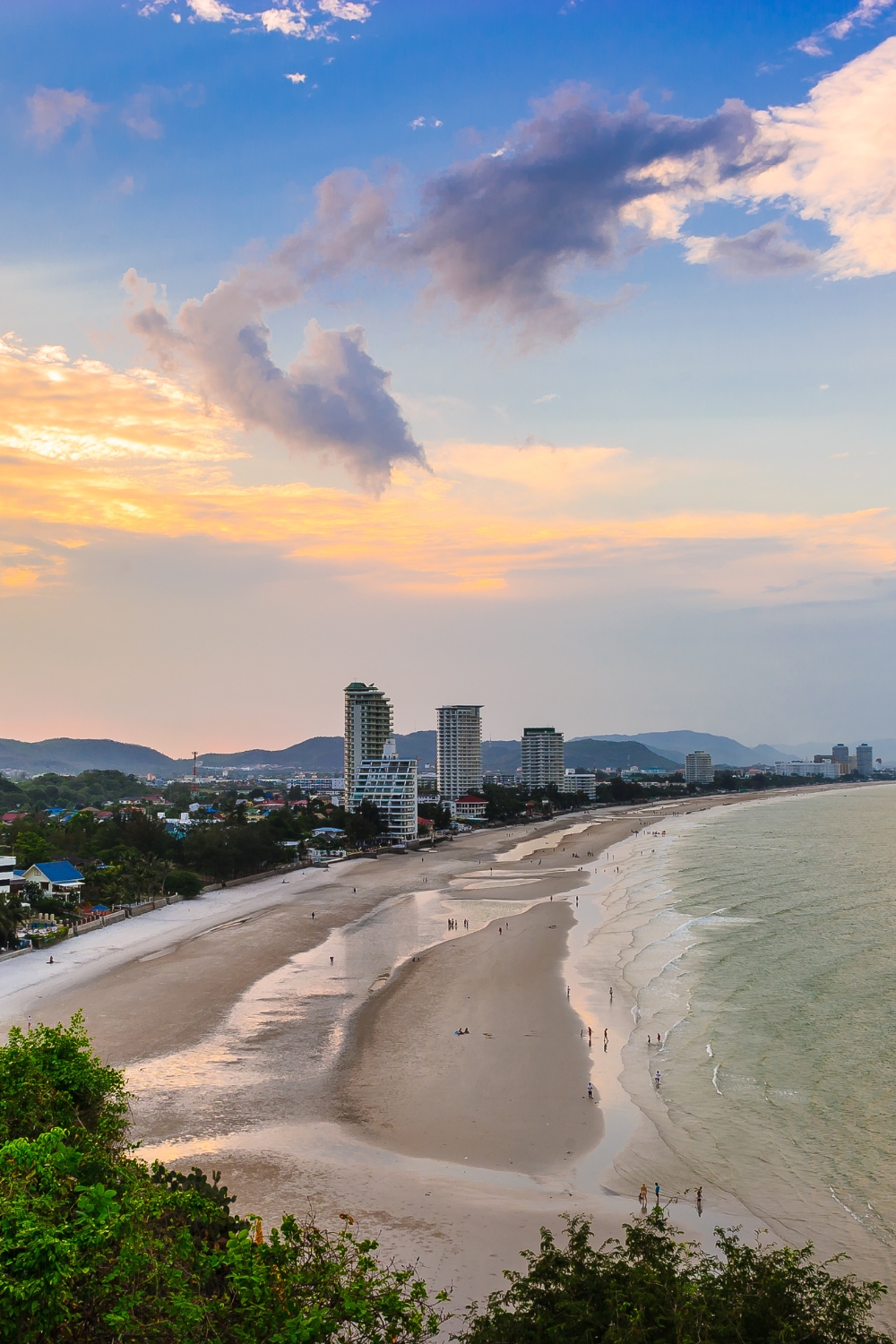
Hua Hin Beach stretches for 5 kilometers along the Gulf of Thailand, offering pristine white sand, gentle waves, and stunning sunsets that have captivated visitors for generations. This royal beach maintains its natural beauty while providing excellent facilities for swimming, sunbathing, and water sports.
Family-Friendly Swimming and Beach Activities
The beach’s calm, shallow waters make it ideal for families with children and swimmers of all skill levels. Unlike many Thai beaches, Hua Hin’s coastline remains relatively uncrowded, allowing visitors to find peaceful spots for relaxation even during peak tourist seasons.
Colorful wooden fishing boats dot the shoreline, creating picture-perfect scenes that reflect Hua Hin’s traditional fishing heritage. Local fishermen still launch their boats from the beach each morning, providing authentic glimpses of coastal Thai life.
Beach activities include horseback riding along the shore, kitesurfing, windsurfing, and banana boat rides. The southern end of the beach offers quieter areas for meditation and yoga, while the northern section provides more active water sports and beachfront dining options.
Best time to visit: Early morning for sunrise views or late afternoon for golden hour photography
Beach facilities: Restrooms, showers, umbrella rentals, and beachfront restaurants
Water sports: Kitesurfing, windsurfing, jet skiing, and parasailing available
2. Hua Hin Railway Station – Architectural Gem
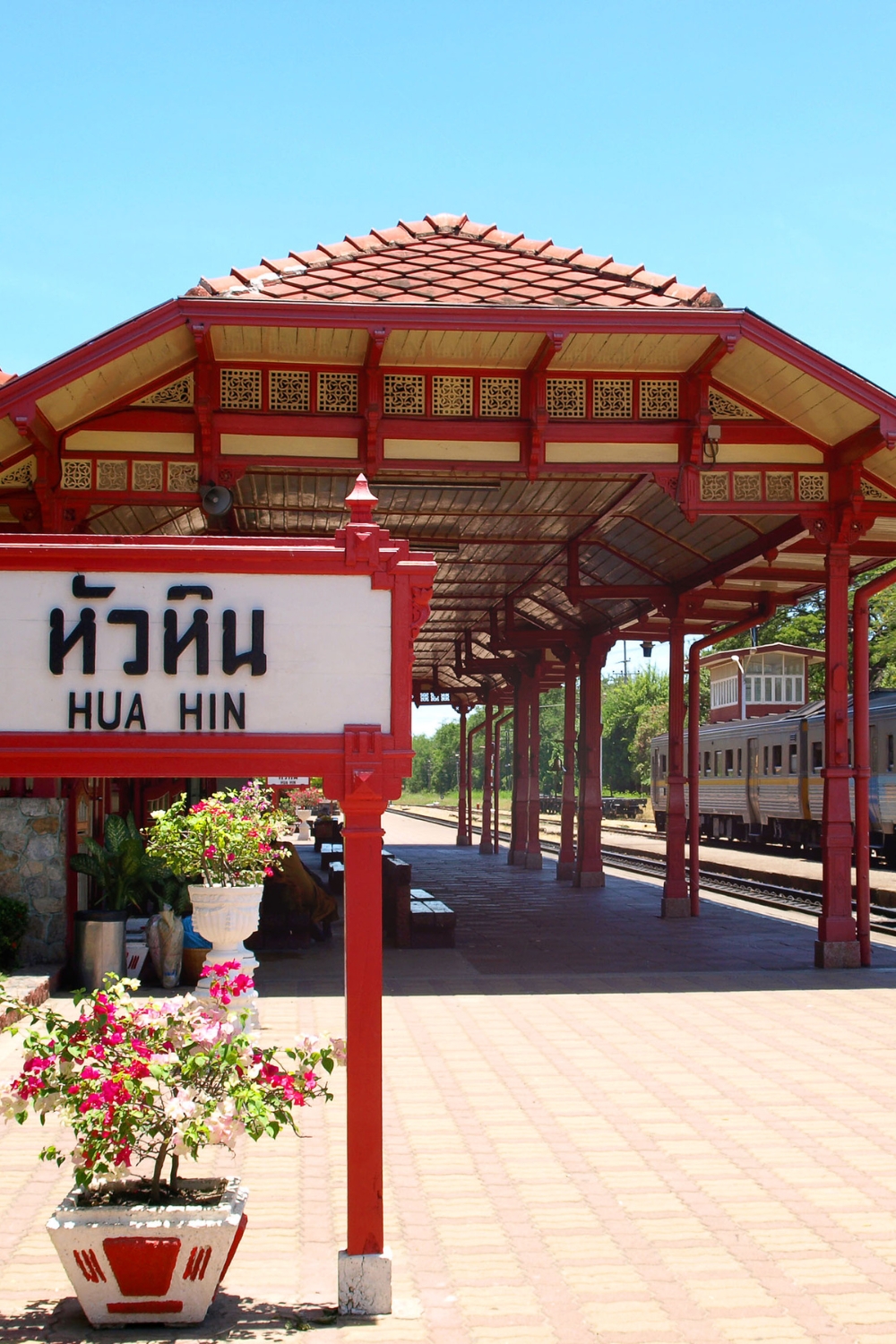
Hua Hin Railway Station ranks among Thailand’s most beautiful train stations, featuring stunning traditional Thai architecture that has remained virtually unchanged since its construction in 1926. This historic station serves as both a functioning transport hub and a popular tourist attraction.
Royal Waiting Room and Historic Architecture
The station’s most famous feature is the Sala Rong Nam (Royal Waiting Room), originally built for King Rama VII’s visits to Hua Hin. This elegant pavilion showcases classic Thai architectural elements including intricate wooden carvings, traditional roof lines, and vibrant red and gold decorations.
The main station building displays a perfect blend of European colonial and traditional Thai design influences. Its distinctive architecture reflects the era when European advisors influenced Thai construction while local craftsmen maintained traditional decorative techniques.
Trains still arrive daily from Bangkok’s Thonburi Station, making the railway station a practical starting point for exploring Hua Hin. The journey from Bangkok takes approximately 4 hours and offers scenic views of Thai countryside and coastal landscapes.
Historical significance: Built during King Rama VII’s reign as royal transportation hub
Architectural style: Thai traditional design with European colonial influences
Photography tips: Best lighting during morning hours for exterior shots
3. Cicada Market – Creative Night Bazaar
Cicada Market transforms Hua Hin’s evenings into vibrant celebrations of Thai creativity, featuring handmade crafts, artistic performances, and innovative street food. This award-winning night market focuses on supporting local artists and preserving traditional Thai handicraft skills.
Artisan Crafts and Cultural Performances
The market showcases authentic Thai handicrafts including hand-woven textiles, carved wooden sculptures, ceramic pottery, and silver jewelry created by local artisans. Unlike typical tourist markets, Cicada emphasizes quality craftsmanship and unique artistic designs.
Live cultural performances include traditional Thai music, folk dancing, puppet shows, and contemporary art exhibitions. The market’s outdoor amphitheater hosts concerts and theatrical performances that blend traditional and modern Thai cultural expressions.
Food vendors offer creative interpretations of classic Thai dishes alongside international fusion cuisine. The market’s restaurant area features communal seating where visitors can enjoy meals while watching cultural performances under the stars.
Operating hours: Friday to Sunday, 4:00 PM – 11:00 PM
Specialties: Handmade crafts, live performances, fusion cuisine
Cultural events: Traditional music and dance performances throughout the evening
4. Maruekhathaiyawan Palace – Teakwood Royal Residence
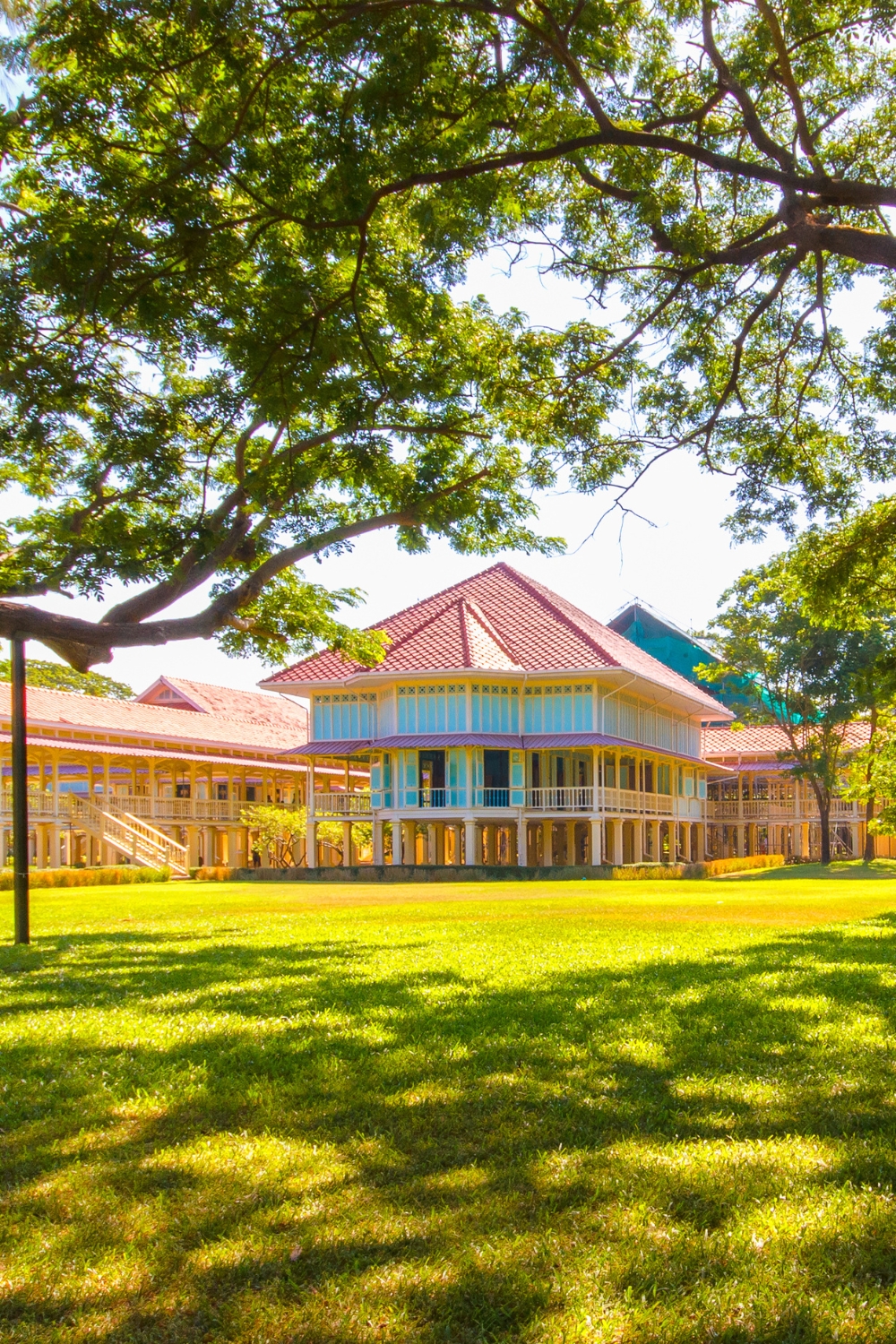
Maruekhathaiyawan Palace, known as the “Palace of Love and Hope,” represents one of Thailand’s most beautiful examples of traditional teakwood architecture. Built in 1923 as King Rama VI’s summer residence, this golden teakwood palace demonstrates royal architectural excellence.
Traditional Thai Royal Architecture
The palace consists of 16 connected buildings constructed entirely from golden teakwood without using a single nail. Traditional Thai joinery techniques hold the entire structure together, showcasing the incredible skill of early 20th-century Thai craftsmen.
Elevated walkways connect different palace sections, originally designed to catch sea breezes and provide natural cooling. The palace’s open-air design maximizes ventilation while offering stunning views of the surrounding pine forest and nearby coastline.
Each room displays period furniture, royal artifacts, and historical photographs that provide insight into royal life during the early modern period. The king’s private study, bedroom, and reception halls remain preserved exactly as they appeared during royal occupation.
Construction period: 1923-1924 during King Rama VI’s reign
Architectural features: Traditional teakwood construction, elevated walkways, natural ventilation
Guided tours: Available with detailed historical information about royal life
5. Khao Takiab (Monkey Mountain) – Temple and Panoramic Views
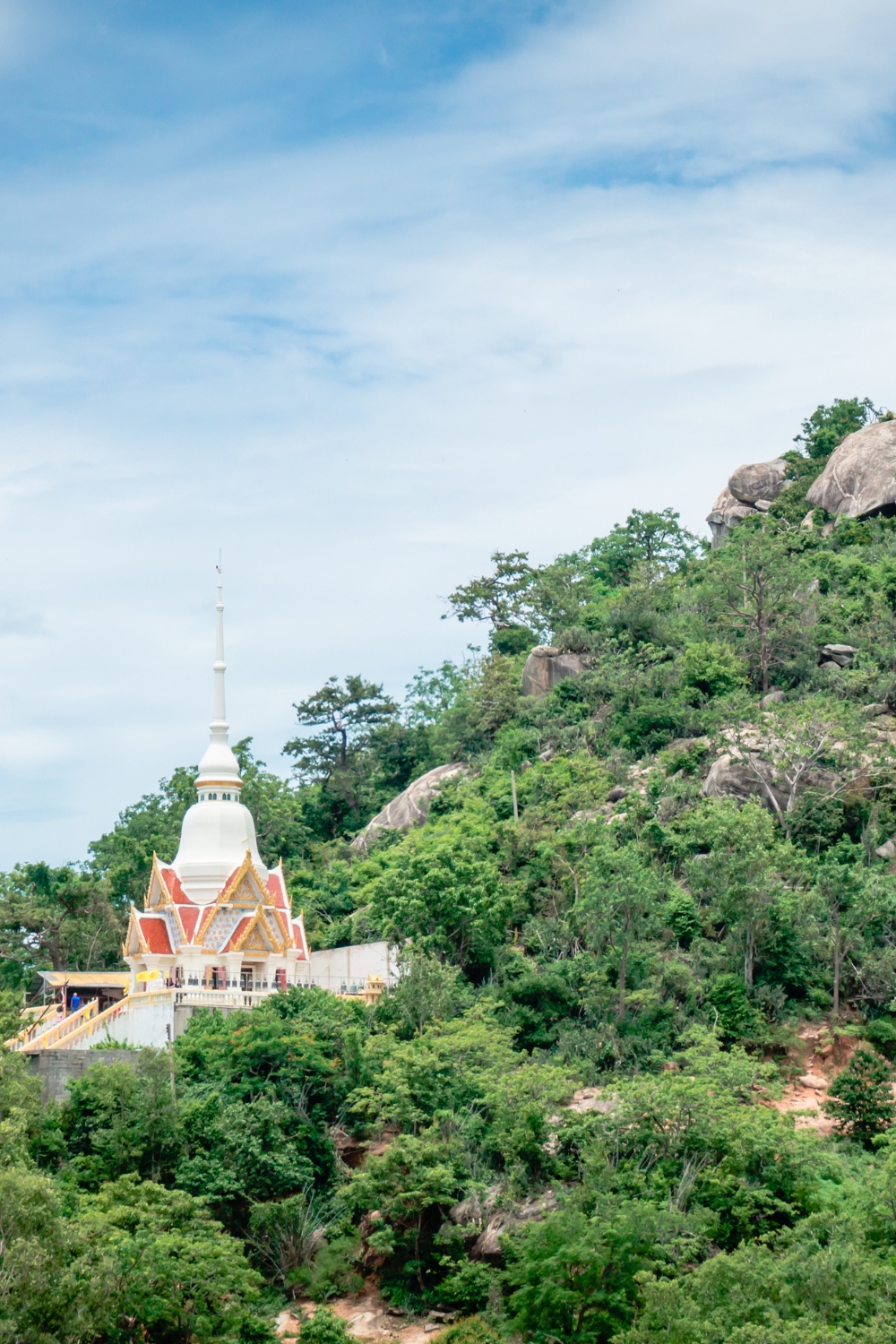
Khao Takiab rises 272 meters above sea level, creating Hua Hin’s most recognizable landmark topped by a gleaming white temple that can be seen from throughout the region. This sacred mountain offers spectacular panoramic views and important Buddhist pilgrimage sites.
Buddhist Temple Complex and Wildlife Encounters
Wat Khao Takiab temple complex crowns the mountain summit with impressive Buddha statues, ornate prayer halls, and meditation areas that attract Buddhist pilgrims from across Thailand. The temple’s white and gold architecture creates striking contrasts against blue sky and green forest backgrounds.
The mountain’s name translates to “Chopstick Hill” due to its pointed shape resembling giant chopsticks. Hundreds of macaque monkeys inhabit the mountain slopes, entertaining visitors but requiring caution as they can be aggressive when seeking food.
The climb to the summit takes 30-45 minutes via concrete stairs winding through tropical forest. Alternative transportation includes songthaews (shared taxis) that drive to parking areas near the temple complex.
Temple features: Golden Buddha statues, prayer halls, meditation areas
Wildlife: Macaque monkeys, tropical birds, monitor lizards
Climbing difficulty: Moderate, with stairs and rest areas along the route
6. Hua Hin Night Market – Street Food Paradise
Hua Hin Night Market represents the heart of local social life, offering authentic Thai street food, fresh seafood, and affordable shopping in a bustling atmosphere that captures the essence of Thai market culture.
Authentic Street Food and Local Shopping
The market’s food section features over 100 vendors serving everything from traditional som tam (papaya salad) and pad thai to fresh grilled seafood caught daily by local fishermen. Many stalls have operated for decades, perfecting family recipes passed down through generations.
Seafood restaurants within the market offer “choose your own” dining experiences where customers select fresh fish, prawns, crabs, and squid from ice displays. Skilled cooks prepare selections using traditional Thai cooking methods and authentic regional spices.
Shopping areas include clothing stalls, souvenir vendors, and local product sellers offering everything from Thai silk scarves to handmade soaps. Prices remain reasonable compared to tourist-focused shopping areas, making it popular with both locals and visitors.
Operating hours: Daily 6:00 PM – 12:00 AM
Specialties: Fresh seafood, traditional Thai street food, local handicrafts
Dining tips: Look for stalls with high customer turnover for the freshest food
7. Klai Kangwon Palace – Active Royal Residence
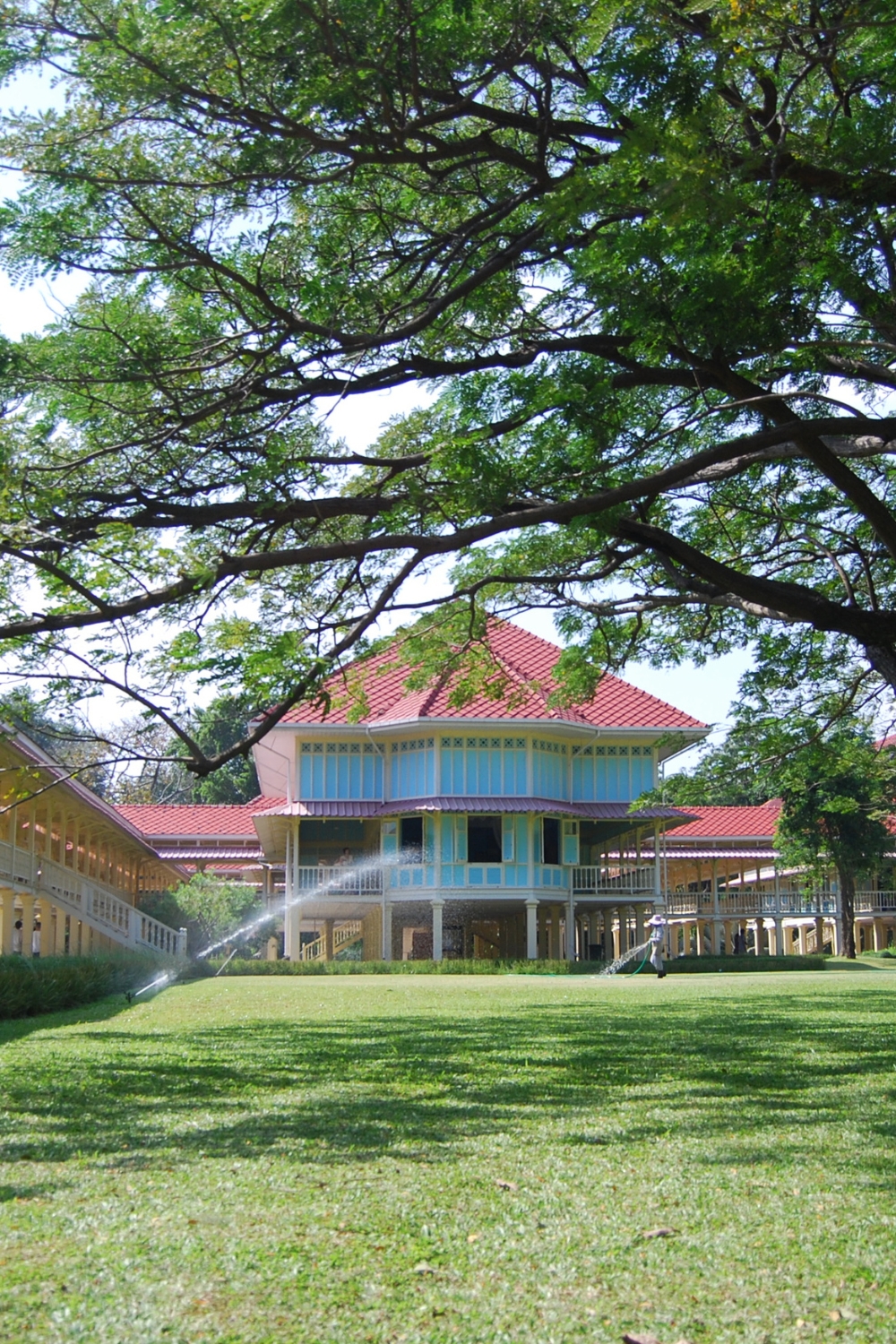
Klai Kangwon Palace serves as the current Thai royal family’s official seaside residence, meaning “Far from Worries” in Thai. While the palace interior remains closed to public tours, its beautiful grounds and historical significance make it an important Hua Hin landmark.
Royal Heritage and Palace Grounds
Built in 1926 for King Rama VII, the palace has hosted every Thai monarch since its construction. The current King continues using the palace as his primary residence outside Bangkok, making Hua Hin an active center of modern Thai royal life.
The palace’s Spanish colonial architecture differs significantly from traditional Thai royal design, reflecting the international influences present during the early 20th century. White stucco walls and red tile roofs create Mediterranean aesthetics adapted for tropical climates.
Public areas around the palace offer peaceful walking paths through beautifully maintained gardens featuring tropical plants, ornamental ponds, and sculptured landscapes. The nearby beach areas provide excellent views of the palace’s seaside location.
Architectural style: Spanish colonial design with tropical adaptations
Current status: Active royal residence, exterior viewing only
Historical importance: Continuous royal use since 1926
8. Elephant Village – Ethical Wildlife Encounters
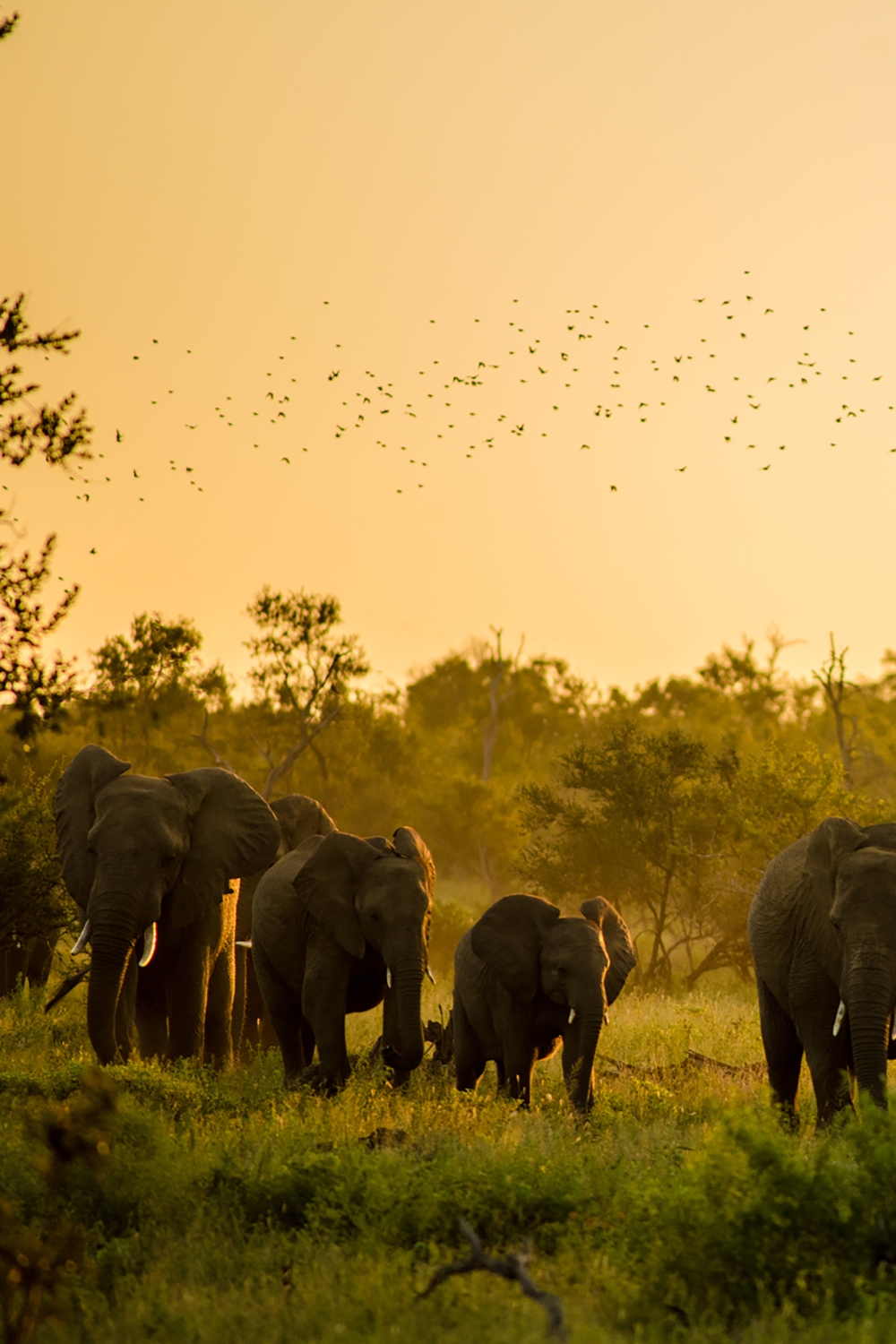
Elephant Village provides ethical elephant encounters focused on conservation, education, and supporting rescued elephants in natural forest environments. This sanctuary prioritizes elephant welfare while offering visitors meaningful interactions with Thailand’s national animal.
Conservation Education and Elephant Care
The sanctuary houses rescued elephants from logging operations, street begging, and tourism exploitation. Professional mahouts (elephant keepers) provide expert care while educating visitors about elephant behavior, intelligence, and conservation challenges.
Educational programs teach visitors about elephant biology, social structures, and the threats facing wild elephant populations. Interactive feeding sessions allow close encounters while respecting elephant natural behaviors and maintaining safe distances.
Forest walks with elephants provide opportunities to observe these magnificent animals in semi-natural environments. The sanctuary’s 200-acre forest setting allows elephants to roam, bathe in natural ponds, and engage in normal social behaviors.
Elephant activities: Feeding, bathing, forest walks, educational programs
Conservation focus: Rescued elephant rehabilitation and public education
Booking requirements: Advance reservations recommended, especially during peak season
9. Hua Hin Hills Vineyard – Tropical Wine Experience
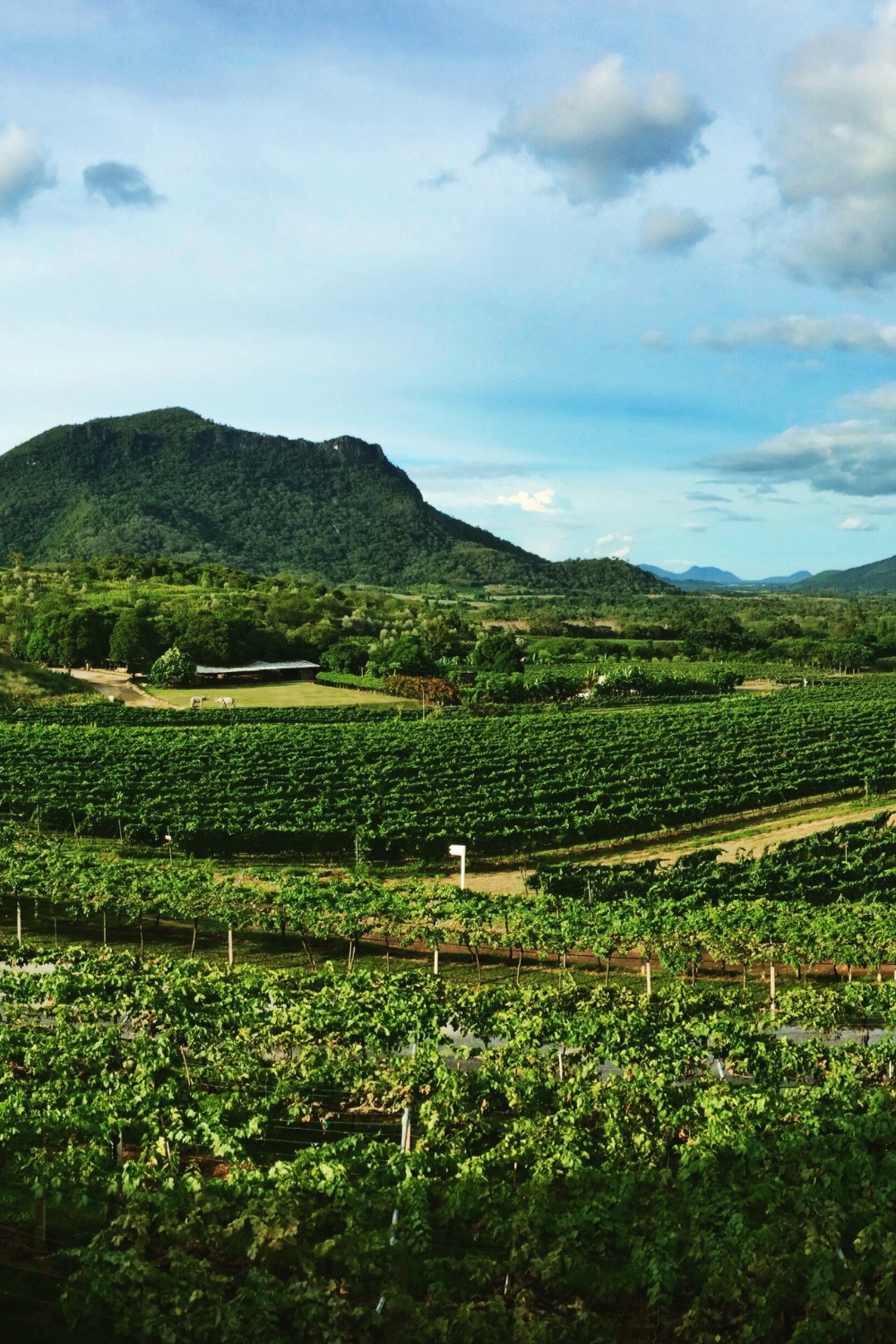
Hua Hin Hills Vineyard pioneers tropical winemaking in Thailand, creating award-winning wines from grapes grown in the unique climate conditions of coastal Thailand. This family-owned vineyard offers tours, tastings, and dining experiences in stunning hillside settings.
Winemaking Innovation and Scenic Dining
The vineyard grows both international grape varieties and experimental hybrids adapted to Thailand’s tropical climate. Innovative cultivation techniques include multiple harvests per year and specialized irrigation systems that manage monsoon rainfall patterns.
Wine tasting sessions include education about tropical winemaking challenges and techniques used to create quality wines in non-traditional climates. Professional sommeliers guide tastings of white, red, and sparkling wines produced entirely on-site.
The vineyard’s restaurant serves Mediterranean-Thai fusion cuisine paired with estate wines, offering dining terraces with panoramic views over vineyard slopes toward the Gulf of Thailand. Sunset dinner experiences provide romantic settings surrounded by grape vines and mountain landscapes.
Wine varieties: Chenin Blanc, Shiraz, Tempranillo, and experimental tropical hybrids
Tour options: Vineyard walks, winemaking demonstrations, tasting sessions
Dining: Mediterranean-Thai fusion cuisine with wine pairings
10. Sam Roi Yot National Park – Coastal Wilderness Adventure
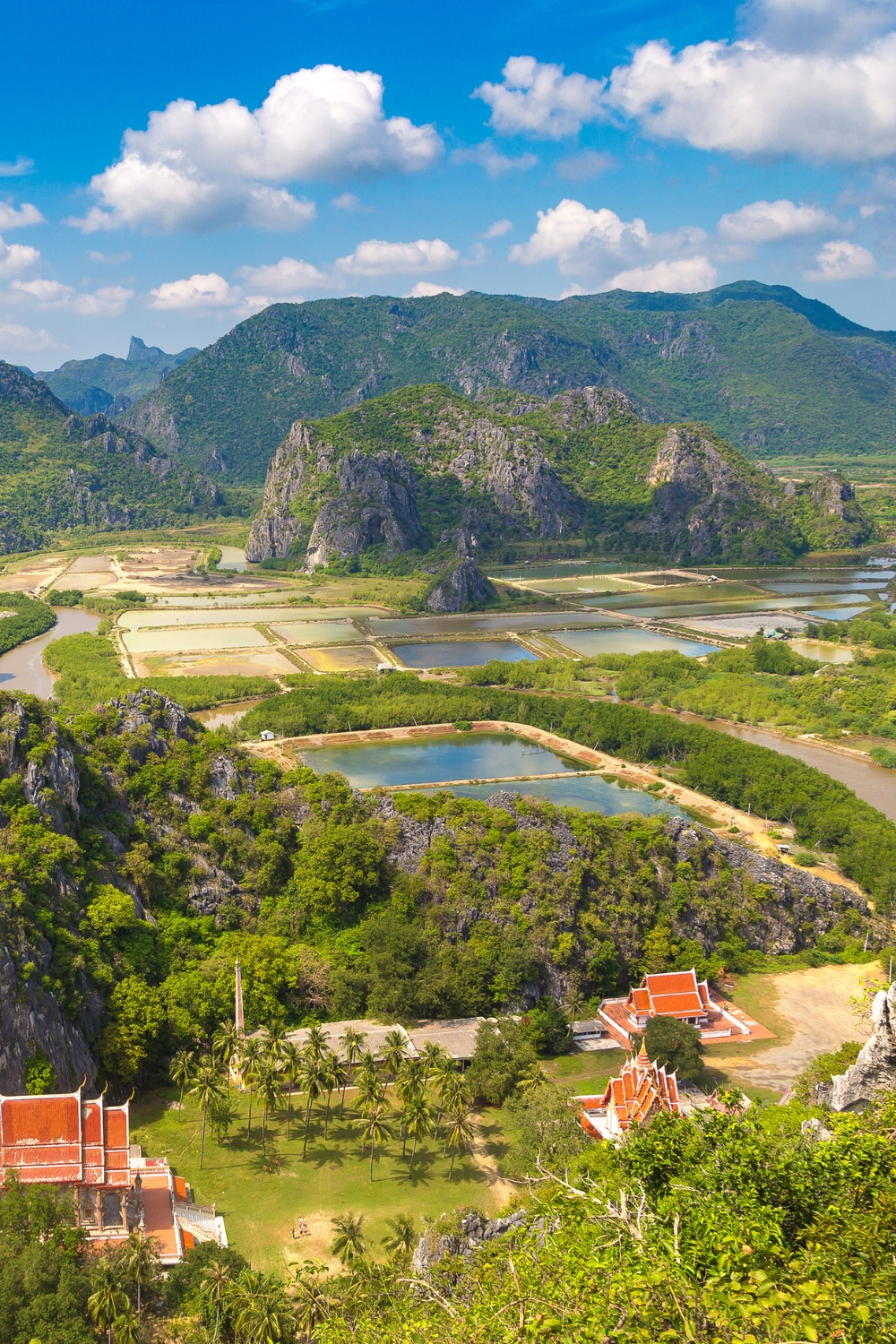
Sam Roi Yot National Park, located 30 kilometers south of Hua Hin, protects diverse coastal ecosystems including limestone mountains, pristine beaches, mangrove forests, and freshwater marshes. The park’s name means “Three Hundred Peaks,” referring to its dramatic limestone formations.
Limestone Caves and Pristine Beach Ecosystems
Phraya Nakhon Cave serves as the park’s most famous attraction, housing a royal pavilion built for King Rama V’s 1890 visit. Sunlight streaming through the cave’s collapsed roof creates magical illumination of the ornate pavilion, making it one of Thailand’s most photographed landmarks.
The park’s beaches remain completely undeveloped, offering pristine white sand, clear water, and nesting sites for sea turtles. Laem Sala Beach provides excellent swimming and snorkeling opportunities with minimal tourist development.
Freshwater marshes support over 300 bird species, making the park a premier birdwatching destination. Migratory species arrive between November and March, while resident tropical birds can be observed year-round.
Key attractions: Phraya Nakhon Cave, pristine beaches, birdwatching areas
Activities: Cave exploration, beach relaxation, wildlife photography, hiking
Best time to visit: November to April for optimal weather and wildlife viewing
Planning Your Hua Hin Adventure
Getting to Hua Hin
Hua Hin is easily accessible from Bangkok by multiple transportation options. The most convenient is driving or taking a bus, which takes approximately 3 hours via Highway 35. Train travel from Bangkok’s Thonburi Station offers scenic routes but takes longer at 4-5 hours.
Best Time to Visit
The ideal time to visit Hua Hin is during the cool dry season from November to February, when temperatures range from 20-30°C and rainfall is minimal. March to May can be hot and humid, while June to October brings monsoon rains.
Accommodation Options
Hua Hin offers accommodation ranging from budget guesthouses to luxury beach resorts. Beachfront hotels provide ocean views and easy beach access, while town center accommodations offer walking access to markets and restaurants.
Transportation Within Hua Hin
Renting a motorbike or car provides flexibility for exploring attractions outside town. Songthaews (shared taxis) connect major destinations within Hua Hin, while tuk-tuks offer convenient short-distance transportation.
Essential Travel Tips
Cultural Respect and Etiquette
When visiting temples and royal sites, dress modestly covering shoulders and knees. Remove shoes before entering temple buildings and maintain quiet, respectful behavior during religious ceremonies.
Beach and Ocean Safety
Hua Hin’s beaches are generally safe for swimming, but be aware of seasonal jellyfish and strong currents during monsoon periods. Use reef-safe sunscreen to protect marine ecosystems.
Wildlife Interaction Guidelines
When encountering monkeys at Khao Takiab or elephants at sanctuaries, maintain respectful distances and never feed wild animals. Follow guide instructions for safe and ethical wildlife experiences.
Local Cuisine Adventures
Hua Hin’s street food is generally safe, but choose vendors with high customer turnover for the freshest options. Try local specialties like hua hin-style fried noodles and fresh seafood preparations.
Conclusion
Hua Hin offers an enchanting blend of royal heritage, natural beauty, and authentic Thai culture that creates unforgettable travel experiences. From the architectural elegance of historic railway stations to the pristine wilderness of national parks, this coastal paradise provides diverse attractions for every type of traveler.
The town’s unique position as both a working fishing village and royal resort destination creates a fascinating cultural dynamic rarely found in other Thai beach destinations. Local communities maintain traditional ways of life while warmly welcoming visitors seeking authentic cultural exchanges.
Whether you’re interested in exploring Buddhist temples, sampling innovative cuisine, encountering elephants ethically, or simply relaxing on beautiful beaches, Hua Hin delivers experiences that satisfy both adventure seekers and relaxation enthusiasts.
Plan your Hua Hin journey with appreciation for its royal heritage, respect for its natural environments, and openness to cultural learning. This remarkable destination will provide insights into Thailand’s rich history while creating lasting memories of its present-day charm and hospitality.
